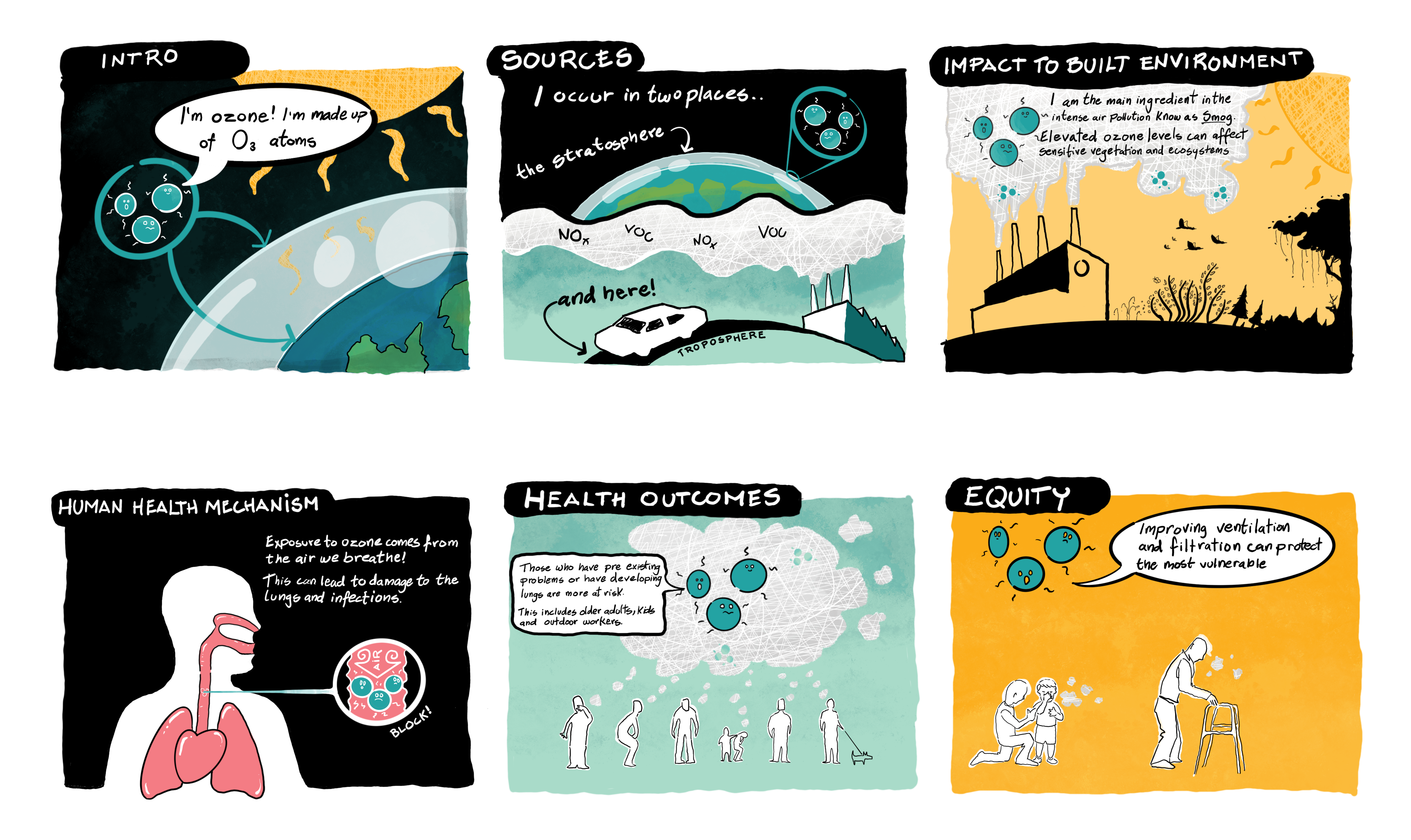
Click here for caption
Transcript: Hi, I’m Ozone! I’m made up of three oxygen atoms and live in the upper atmosphere and at the ground level. I occur naturally at the upper atmosphere and protect Earth from ultraviolet radiation. On the ground level, I’m formed by chemical reactions between nitrogen oxides (emitted from combustion engines) and other compounds. Ozone is most likely to reach unhealthy levels on hot sunny days in the city, but can still reach high levels during colder months too. Ozone is also able to travel long distances by wind, so it can reach well beyond the city as well. Ozone is particularly harmful to our respiratory system, causing the airways to constrict and trapping the air from flowing. This can lead to damage to the lungs and infections, depending on how much ozone you are exposed to. Those who already have pre-existing respiratory conditions will be most at-risk of the harms of ozone. These include those with asthma, as well as children who are still developing their lungs. Others include older adults, and people who are active outside, such as outdoor workers.
Definition
Ozone is a gas made of three oxygen atoms and occurs both in the upper atmosphere and at ground level. Upper atmosphere or stratospheric ozone occurs naturally and protects the planet from ultraviolet radiation. Ground-level ozone is formed by chemical reactions between nitrogen oxides and volatile organic compounds and can be exacerbated by extreme heat.Human Health Mechanism
Even at low concentrations, ozone can cause health effects including coughing, scratchy throat, damage to airways, increased risk of lung infection, and increased asthma attack frequency. High levels of ambient ozone air pollution also impact educational outcomes. For instance, higher levels of ozone pollution around schools have been linked to poorer academic performance. As of 2021, 28.1 million children and 18.2 million adults over 65 live in areas with high levels of ozone air pollution in the U.S.Indicator Measurement
Data on ozone are provided by the US Environmental Protection Agency’s (US EPA) EJScreen, an environmental justice screening tool that uses national data to map places that are more vulnerable and susceptible to environmental burdens. The ozone indicator data were provided by US EPA Office of Air Quality Planning and Standards (OAQPS) using a mix of actual monitoring results and Community Multiscale Air Quality (CMAQ) air quality modeling. USEPA’s EJScreen presents the annual mean of the 10 highest ozone concentrations modeled by census tract to measure of potential exposure to ground level ozone.Source of Exposures
Ground-level ozone is created when pollutants emitted from cars, power plants, refineries, industrial boilers, and other sources chemically react in the sunlight.Related Health Outcomes & Exposures
PM2.5, Traffic Proximity, Extreme HeatReferences
Click here for References
- Ozone Data Source: US EPA. EJScreen: Ozone. Data year 2019. Retrieved April 2023 from https://www.epa.gov/ejscreen/download-ejscreen-data
- Centers for Disease Control and Prevention (CDC). Air Pollution. Updated December 21, 2020. Accessed October 12, 2023. https://www.cdc.gov/climateandhealth/effects/air_pollution.htm
- Eitland E, Klingensmith L, MacNaughton P, et al. Schools For Health. 2017. Accessed October 19, 2023. https://forhealth.org/Harvard.Schools_For_Health.Foundations_for_Student_Success.pdf.
- Lu W, Hackman DA, Schwartz J. Ambient air pollution associated with lower academic achievement among US children: A nationwide panel study of school districts [published correction appears in Environ Epidemiol. 2022 Feb 25;6(2):e202]. Environ Epidemiol. 2021;5(6):e174. Published 2021 Nov 3. doi:10.1097/EE9.0000000000000174
- National Institute of Environmental Health Sciences (NIEHS). Air Pollution and your Health. September 8, 2023. Accessed October 12, 2023. https://www.niehs.nih.gov/health/topics/agents/air-pollution/index.cfm.
- Ramaswamy V, Chanin ML ., Angell J, et al. Stratospheric Temperature trends: Observations and Model Simulations. Reviews of Geophysics. 2001;39(1):71-122. doi:10.1029/1999rg000065
- US EPA. EJScreen Technical Documentation for Version 2.2. Updated July 2023. Accessed November 21, 2023. https://www.epa.gov/ejscreen/technical-information-about-ejscreen#:~:text=EJScreen%20Technical%20Documentation%20(pdf)
- US EPA. Climate change indicators: Wildfires. Updated July 21, 2023. Accessed October 12, 2023. https://www.epa.gov/climate-indicators/climate-change-indicators-wildfires.
- USEPA. Actions You Can Take to Reduce Air Pollution. Updated July 2023. Accessed October 12, 2023. https://www3.epa.gov/region1/airquality/reducepollution.html
- Zhang JJ, Wei Y, Fang Z. Ozone Pollution: A Major Health Hazard Worldwide. Front Immunol. 2019;10:2518. Published 2019 Oct 31. doi:10.3389/fimmu.2019.02518
